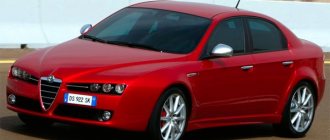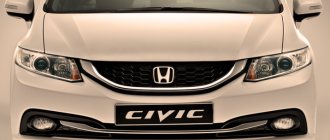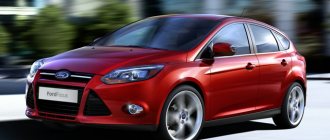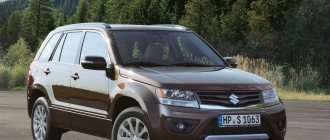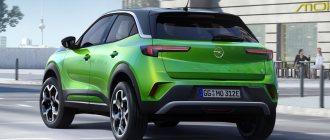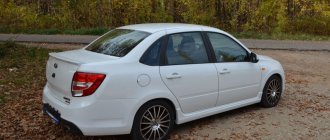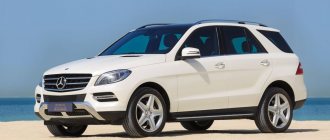The second generation Nissan Teana was introduced in 2008. The model is built on the Nissan D platform, common with the Nissan Murano and Infiniti JX/QX60. For the Russian market, the car was produced in Japan. In the summer of 2009, assembly started in Russia - in St. Petersburg. In 2011, Teana underwent restyling. Changes affected the interior and rear lights. In 2014, a generational change occurred.
The Nissan Teana looks larger and more solid than it actually is, including due to the large number of chrome parts in the exterior design. True, reversing can sometimes cause some difficulties. There are no parking sensors here, and the rear view camera gets dirty easily.
The Teana's cabin is made to last and is quite wide, even by business class standards. The standard audio system is equipped with excellent Bose speakers. Noise insulation is performed at a decent level.
Miscalculations in the interior concern only ergonomics. The steering wheel is not adjustable for reach, and the driver's seat has height adjustment only in rich trim levels, not to mention lumbar support. The buttons for controlling the heated front seats hidden in the armrest are also a very controversial solution.
The basic version of the sedan was equipped with ABS, dual-zone climate control, heated front seats, full power accessories, a multifunctional on-board computer, a radio with a CD changer and AUX output, four airbags, a security alarm and a keyless entry system for the “Intelligent Key” interior. Top versions include xenon, leather interior and navigation.
Engines
The Nissan Teana was equipped with three naturally aspirated petrol engines. Two of them had a volume of 2.5 liters, but differed in the design of the block. The QR25DE (167 hp) was an inline four, and the VQ25DE (182-185 hp) was a V-shaped six. The flagship 3.5-liter V6, designated VQ35DE, developed 249 hp.
All motors demonstrate exemplary reliability, showing no weaknesses. The gas distribution mechanism is driven by a chain, which, as a rule, does not require attention.
"Nissan-Teana", from 969,000 rubles.
Loading suitcases
The trunk is not the most convenient - another characteristic feature of the Teana that should be taken into account before purchasing. After all, this car was created not as a family transport, but as a business sedan. That’s why the cargo capabilities of the big Nissan are not so hot. You will not find a folding backrest here - only a small (18 by 22 cm) hatch for transporting long items. Hooks, fastening loops, and nets are also not provided. The trunk volume is 488 liters, and it is quite deep and wide. The opening here is not so small (51 cm). But the far-from-correct parallelepiped shape of the hold with its various nooks and crannies leaves much to be desired.
Behind the wheel
But “Teana” is completely rehabilitated when you find yourself behind the wheel. An unexpectedly plump and soft chair takes you into the dark embrace. It seems that in principle this cannot have at least some lateral support. However, unlike the driver's seat of the previous Teana, you soon discover that its shape, profile and, most importantly, support for the hips and back are close to optimal. This is thanks to the new three-layer “filling”.
The steering wheel is only adjustable for tilt. But this does not interfere with the comfortable fit even for those who have grown up to 185 cm. You just need to follow our advice and choose the optimal “Elegance+”. You just move just enough so that you don’t have to reach for the steering wheel, and the wide range of electrically adjustable cushion angles will help ensure that your feet don’t hang over the pedals.
To start the engine, the key, or rather, the key fob, does not need to be inserted into the port to the right of the steering wheel - just press the button on the dashboard. However, if you often lose even larger items in your pockets, then the slot in the front panel will be a logical place to store the key.
In general, all the controls are in place here. Everything turns on clearly and almost everything is readable. There is one exception - the control knobs located too low cover the climate control icons. And also the symbols under them are written in English. Although a person gets used to everything, and I succeeded in a couple of days.
Surprisingly, the ergonomics of the basic Elegance and Elegance + are better. The center console is simpler here, and this simplicity is its strength. The control unit for 2-zone climate control is located in place of the multifunctional wheel, which controls navigation and service functions. With this scheme, you can select the desired modes almost blindly.
As for general flaws, there are few of them. The car has small exterior mirrors, and the interior mirrors are small. Therefore, rear parking sensors will not be superfluous. True, “Luxury” and “Premium” have a rear view camera. But they are not supposed to have parking sensors either. But any video eye has a limited viewing angle, so without an audible buzzer, another obstacle at the edges of the bumper may not be noticed.
Finally, the last nuance that you will have to get used to is the dozen buttons in the “blind” zone to the left of the steering wheel.
Variable speed drive
Paired with the engines is a Jatco variator: with 2.5 liters – JF011E, and with 3.5 liters – JF010E. The variator is very capricious and needs regular oil changes - at least once every 50-60 thousand km. There are known cases where careful operation coupled with regular maintenance made it possible to drive almost 400,000 km before the first repair.
However, after 150,000 km, the likelihood of CVT failure increases significantly. A harbinger of trouble will be jolts, jerks, or twitches. Weak points are the belt, solenoids, hydraulic unit and oil pump pressure reducing valve. The differential and bearings may fail. For repairs you will have to stock up on an impressive amount - from 60 to 100 thousand rubles. It is worth noting that the CVT of models with a 3.5-liter engine is much more durable, and, as a rule, arrives for repairs much later.
Transmission
There are also models with all-wheel drive on the market, which were equipped with a 4-cylinder QR25DE engine and a CVT. The proprietary “All Mode 4×4” all-wheel drive system under normal conditions transfers most of the traction to the front wheels. The rear wheels are connected by command from the electronics. For special cases, a forced locking mode of the inter-axle clutch is provided, when the thrust is distributed among the axles in a ratio of 50:50.
There are no serious problems with the transmission yet. Unless there are rare cases of system malfunctions due to damage to the protective corrugation of the electrical harness, and subsequent ingress of moisture.
Restyling
The second generation of Nissan's flagship sedan was updated in 2011.
The front and rear optics have changed in the appearance of the updated car, becoming more modern. Daytime running lights have appeared in the headlights.
The technical part of the improvements was also not affected significantly; the ground clearance for front-wheel drive versions increased from 135 to 150 mm. The engines and gearboxes have not changed.
Chassis
The Nissan Tiana suspension has a very smooth ride. MacPherson struts at the front and a multi-link design at the rear filter out road irregularities well. True, the soft settings of the chassis cause the body to roll heavily in corners.
The front suspension is not durable. Wheel bearings are the first to be handed over - after 60-100 thousand km. They are replaced together with the hub. The cost of the original is about 9,000 rubles, and the analogue is about 6,000 rubles. Rear wheel bearings last longer - more than 150-200 thousand km.
The service life of the front shock absorbers is about 100-150 thousand km. The rear pillars last a little longer. A new original shock absorber will cost 15,000 rubles, an analogue is available from 3,000 rubles. Rear pillars are cheaper - 5,000 and from 1,500 rubles. respectively.
Next, the front suspension arms may begin to wear out - the silent blocks wear out. The cost of a new lever is about 10,000 rubles. The rear suspension arms are much more durable.
After 50-100 thousand km, the rear springs noticeably lose their former elasticity, and the stern sags. The disadvantage significantly reduces the already low ground clearance. New springs don't last long. Many people try to eliminate the defect by installing spacers.
On some examples, destruction of the rear anti-roll bar was encountered. The new stabilizer is available only in the original version for 8,000 rubles.
The steering rack may leak or knock after 100-150 thousand km. The crosspiece at the bottom of the steering shaft can also make a knock. The original is only available assembled with a shaft - about 15,000 rubles. But an option is to replace the crosspiece, the cost of which is only 300 rubles.
Sometimes after 60-120 thousand km the power steering pump began to pump oil. More often the disease occurred in winter. The cost of the original pump is 24,000 rubles, the analogue is 8,000 rubles. The high pressure hose may also leak.
Salon
The interior of Teana retained the general style of the first generation, but became higher quality and richer. The first thing the driver pays attention to is the steering wheel, which has become wider in girth and now fits better in the hands; it still has wood-effect inserts, but they are located in different places.
The dashboard of Teana 2010 has also changed, maintaining the same style as the first generation. Like the J31, there is a large, easy-to-read speedometer in the middle of the dashboard, but now it’s round. On the left is an almost full circle of the tachometer, on the right are scales for fuel level and coolant temperature.
The wood trim on the dashboard, door panels, steering wheel, and central tunnel of the Nissan Teana j32 looks good, although you can see with the naked eye that it is not natural.
The American-style driver and passenger seats are plump and soft with perforated leather inserts, making it comfortable to move slowly in them. But if you drive the Teana actively, then the lateral support is not sufficient.
In the second row, the seats are just as comfortable with excellent, comfortable headrests. Passengers sitting in the back can only sit comfortably together; a third person will not be so comfortable.
The interior of the Teana j32 is rich, solid, comfortable, and pleasant. And it looks more expensive than the Camry 50.
Other problems and malfunctions
The body is not prone to corrosion, however, it is better not to delay the removal of chips. The paintwork is not of very high quality. Often (after 2-3 years) paint swelling on the hood and trunk was observed. The owners were forced to repaint the damaged elements under warranty or at their own expense. Sometimes the chrome elements of the exterior trim quickly deteriorated.
Over time, the front panel, and sometimes other interior parts, begin to creak in the cabin. Despite its decent appearance, the leather upholstery of the seats, steering wheel and gear selector is not durable. Scuffs may appear after 30-70 thousand km.
Some owners complain about the longitudinal play in the driver's seat - the rubber gasket wears out, or the gears in the seat drive break.
The heater fan motor is located before the filter. As a result, debris gets on it and it starts making loud noise. To make the noise disappear, it is enough to remove the motor and clear out all the debris: leaves and needles, and sometimes a piece of seal that has fallen out of nowhere.
The motor driving one of the air conditioner dampers may also make extraneous sounds. It starts to buzz or grind. Lubricating the motor does not always help. Most often it turns out to be already worn out. The manufacturer provides for replacing the drive unit assembly - about 5,000 rubles. However, you can find a new motor (up to 1000 rubles) and replace only that.
"Nissan-Teana", from 969,000 rubles.
Outside and inside
But no matter what version you choose, in any case you will get not just a large and solid car, but a completely modern and respectable business class. Maybe it lacks European sophistication and gloss, but, you see, if you have to pay almost twice as much for these notorious qualities... Do you need it?
Meanwhile, in the second generation, “Teana” became, perhaps, brighter and more athletic. The headlights look more aggressive, the taillights with LEDs are more elegant. The radiator grille is larger and more solid, and the sill and bumpers are emphasized by a strip of chrome.
So the salon looks more expensive than ever. The previous one was created by lovers of right angles; now, instead of a flat dashboard board, a floating, gently curving front panel has appeared. The interior of “Teana” seems especially luxurious when it is wrapped in light beige perforated leather. Together with matte cherry wood inserts, this creates an atmosphere of expensive home comfort.
Separate lampshades for illuminating the side seats of the sofa, adjustable air ducts for rear passengers, an armrest with cup holders - all this is included in the base. Yes, there are no pockets in the rear doors. But magazines and maps can be stored in pockets on the backs of the seats, and an ashtray is enough for all kinds of garbage.
The most comfortable sofa will meet you starting with the “Luxury+” version. Here, on the remote control in the armrest there are buttons for controlling the radio, climate control, sunshade, seat heating and ventilation. That is, in a car for 1.2 million you can get something that you usually only see in an executive suite.
And yet, it’s not so easy to call “Teana” a real personal computer. The fact is that she inherited from her predecessor some oddities in compiling packages, and now sellers have also begun to save where they should not have. Yes, the cabin has a huge amount of legroom and a soft sofa with a chic folding armrest and comfortable headrests. In the new generation, the car has a higher ceiling, which will not interfere even with passengers 190 cm tall (unless the hatch steals 5 cm above the head). However, starting with “Luxury+” (for “Teana-3.5” - with “Luxury”), the right front seat is equipped with a retractable shin support. Here the legs can really rest in weight. Only such luxury would be good for a sofa passenger. But in Russia, unlike Japan, the boss rarely travels in the place of a security guard. Moreover, in September “Teana” lost the ventilation of the sofa and the remote control buttons in the rear armrest. It is clear that they did this in order to reduce the cost of production. The buyer of a “Teana” personal car can only try to look for a car with the right sofa in dealer warehouses, because in official fleet parks they don’t buy cars without sofa ventilation.
It turns out that if you are planning to ride with a driver, sit in the front or you will not receive the proper comfort. Trifle? How to look. It’s these little things that continue to keep Teana at some distance from true premium.
